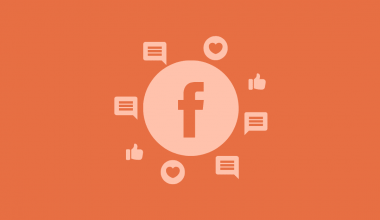How much do Instagram ads cost? What makes Instagram ads worth the price? How can you save on Instagram advertising costs? Keep reading to find out!
Instagram has a 959.7 billion global reach, which has led to a surge in ad costs over the past few years. WebMaxy’s statistics show that Instagram has more than 2.35 billion monthly active users. As such, Instagram offers advertisers a fantastic way to reach new audiences. If you are new to Instagram ads and are curious about the cost of advertising on the platform, you are in the right place.
But before I reveal how much Instagram ads cost, let’s examine the concept of Instagram ads and how they work.
Key Points
- Instagram ads are posts that promote a business’s products or services. The posts can appear in multiple ways, such as an Instagram feed, stories, or both.
- Instagram has a global reach of 959.7 billion and over 2.35 billion monthly active users, making it a valuable platform for advertisers.
- Instagram ads promote products or services through posts in feeds, stories, or both, using images, videos, and links.
- Types of Instagram ads include Stories Ads, Photo Ads, Video Ads, Explore Ads, Carousel Ads
- According to the Meta Business Help Center, Instagram recommends starting with a minimum budget of at least $5 for your ads and running them for more than six days.
What Are Instagram Ads?
Instagram ads are posts that promote a business’s products or services. They can appear in multiple ways, such as an Instagram feed, stories, or both. They can include images or videos along with a copy and a link to the company’s choice’s web page.
How Do Instagram Ads Work?
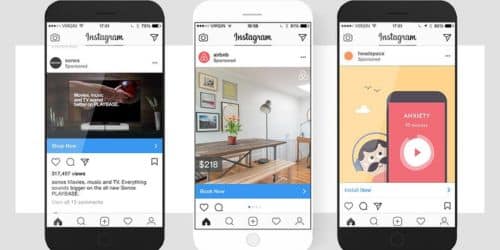
Instagram ads can link to your website, offer visitors the chance to download applications or shop online stores, and have up to eighteen call-to-action button alternatives, depending on the goal of your campaign.
You don’t even need an Instagram account to advertise on Instagram. All you need is a Facebook Business Page because Facebook is the corporation that owns it. However, it is advisable to establish an Instagram account to supplement and enhance your natural Instagram marketing efforts and acquaint yourself with content that most appeals to your target demographic.
To set up Instagram Ads, use Facebook’s Ads Manager to set up campaigns and ad sets where you select your budget, target audience, ad placements, and optimization options. Like Facebook Ads, your ads will run within the selected time frame, budget parameters, audience selection, and optimization goals.
What Are The Different Types of Instagram Ads?
If you’ve been scrolling through your feed on Instagram, you’ve more than likely stumbled upon ads that are so well-curated that they seem like organic posts by someone you already follow. Depending on the campaign’s goal, Instagram ads will be visually set apart by a frame and one of 18 different call-to-actions, or CTAs, including things like “learn more,” “visit site,” “download,” “buy now,” and other ways to get potential customers to engage with a post.
Here’s what advertisers have to choose from:
#1. Stories Ads
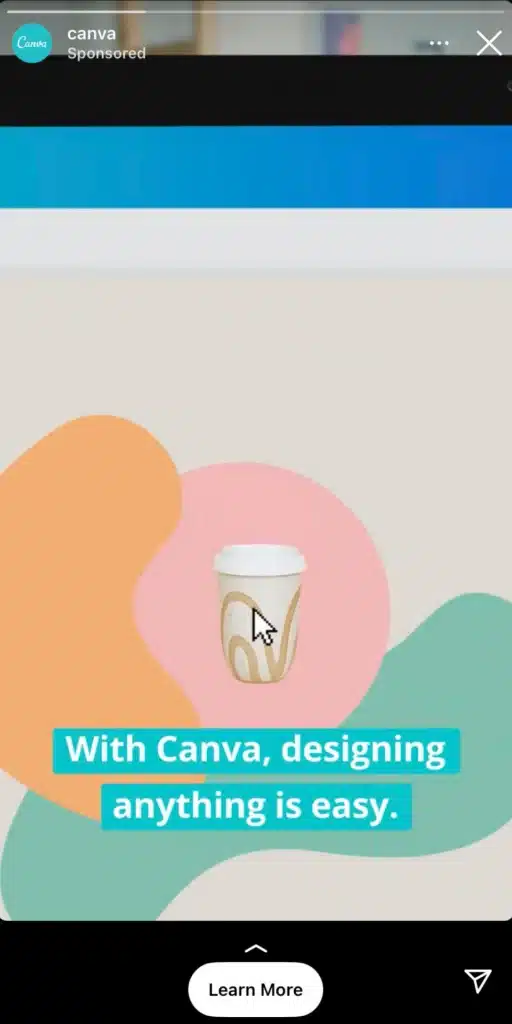
Your Instagram app may notice a scrollable row of bubbles featuring people’s accounts at the top of your screen.
These are called Instagram Stories. So, how do Instagram Story ads work? Stories are quick updates people can tap or swipe through, and your ad will appear when people look through them. While regular creative Instagram posts work best as a square, Stories work best in a vertical format.
You can share images and videos through Stories ads, but remember that something shot horizontally might not work as well as a Story. Stories ads also feature a call-to-action where users can swipe up and be redirected to your landing page.
One relatively new location for ads as of recording this video is IGTV, Instagram’s long-form video feature. I won’t focus too much on IGTV since it hasn’t fully rolled out yet but just know that you may see ads there.
#2. Photo Ads
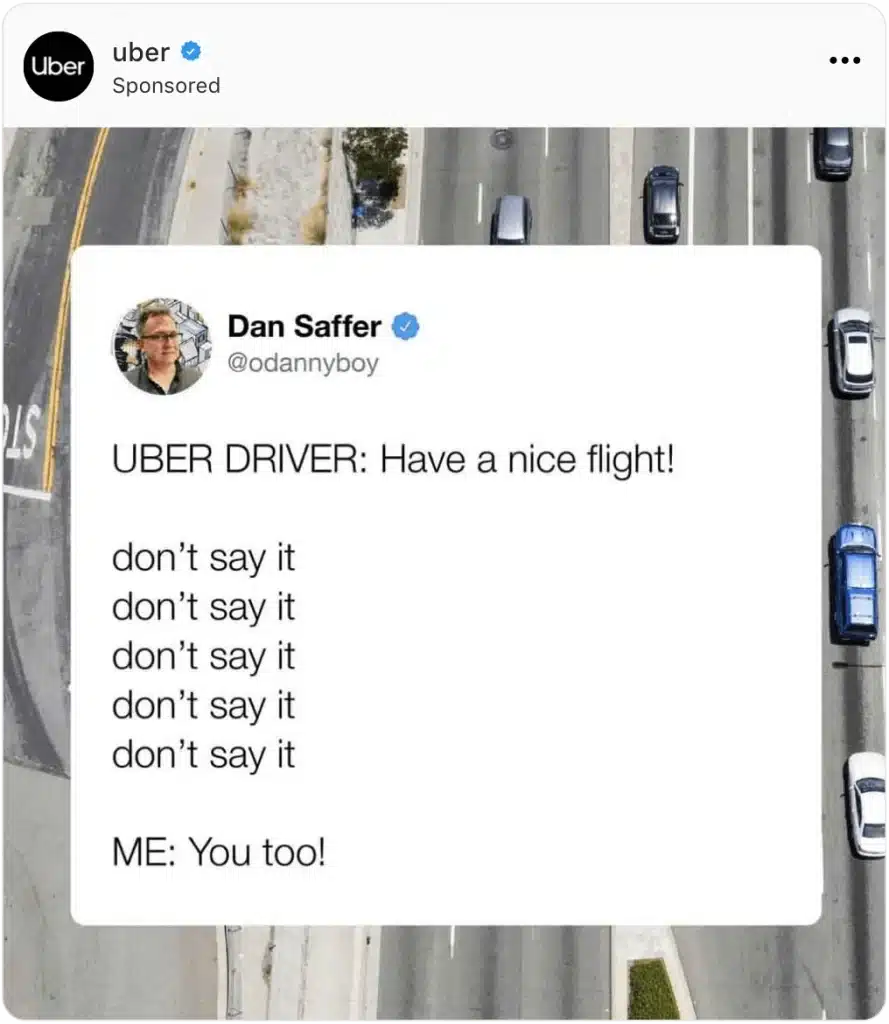
As the name implies, these are the tried-and-true images that appear on a user’s feed when they scroll through it; they are identified by a square or portrait-style frame. Photo ads always include a CTA button and a “sponsored” label to differentiate them from other posts. Customers will concentrate on your image, so it better be excellent. The more original, high-quality images you can employ, the better.
Additionally, keep in mind that the entire Instagram aesthetic is unique and a little odd. You want your photo to grab attention and pique interest. It should provide a key message about your brand while blending in with your customers’ feeds.
#3. Video Ads

These are like a photo ad in that they appear in your audience’s feed, but instead of a still image, you’re using a video that can be up to 60 seconds long. That’s a pretty long ad! To attract and hold a viewer’s attention, these need an eye-catching style that fits in with other content in the viewer’s feed but is just that cut above that grabs their attention.
Videos start playing when a user has them in their view, but they are silent by default–the user has to opt in to hear the message. Be strategic about when you choose to include critical, audible information.
#4. Explore Ads

Next to the home button in your Instagram app, a magnifying glass takes you to the Explore page. Here, Instagram pulls content that you think you will like. So, if you interact with many accounts that make art, you’ll probably see art in your Explore section.
If you tap on a post from the Explore page, you can scroll through many similar posts. You may see an ad every few posts; you’ll know because of that ad tag at the top.
#5. Carousel Ads

These are photo and video ads with more of a ramification. Up to ten images or videos can be included in a single post, which is perfect if you’re exhibiting a variety of goods, traits, services, or apps. It can be more attractive to a larger audience and is a beautiful approach to showcase the diversity of what you have to offer.
One method to personalize what your audience sees is to display carousel ads in the original order you put them in or to display the highest-performing ads first. It could be that small switch that captures and holds their attention.
How Much Do Instagram Ads Cost
Now, to the main point of this guide, let’s examine the average cost per click, cost per engagement, and cost per thousand impressions on Instagram.
- CPC – Cost Per Click: the cost of each click your ad receives based on the total cost of the ad – if you spend $500 and get 1,000 total clicks, you’ve paid an average of $0.50 per click.
- CPM—Cost Per Impressions: CPM means “cost per mille,” which is measured at 1,000 impressions. This tracking is how many times your ad is viewed, whether the potential customer clicks on it or not.
- CPE—Cost Per Engagement: CPE is measured by dividing the advertising cost by the number of “engagements” your ad has produced (e.g., comments, shares, follows, and likes).
On average, business ads on Instagram can cost as little as $0.25 or as much as $2+ per click, anywhere from $4 to $10 per 1,000 impressions, and $0.03 – $0.11 per engagement action. From a monthly point of view, that could be as little as $500 or as much as $5,000 per month if it’s the best place to find and interact with your targeted audience. How much you should spend on monthly Instagram ads will depend on your budget, target audience, and the return you’ll likely see from the investment.
Now that you know the relevant averages, you probably wonder what determines Instagram advertising costs. The simple answer is that your Instagram ad costs depend entirely on you and your determined monthly budget. It’s also worth noting that Meta recommends starting with at least $5.00 per day, or roughly $150 per month for each ad campaign you run.
To calculate your cost on Instagram ads, you can use this calculator
Factors That Influence Instagram Ads Costs
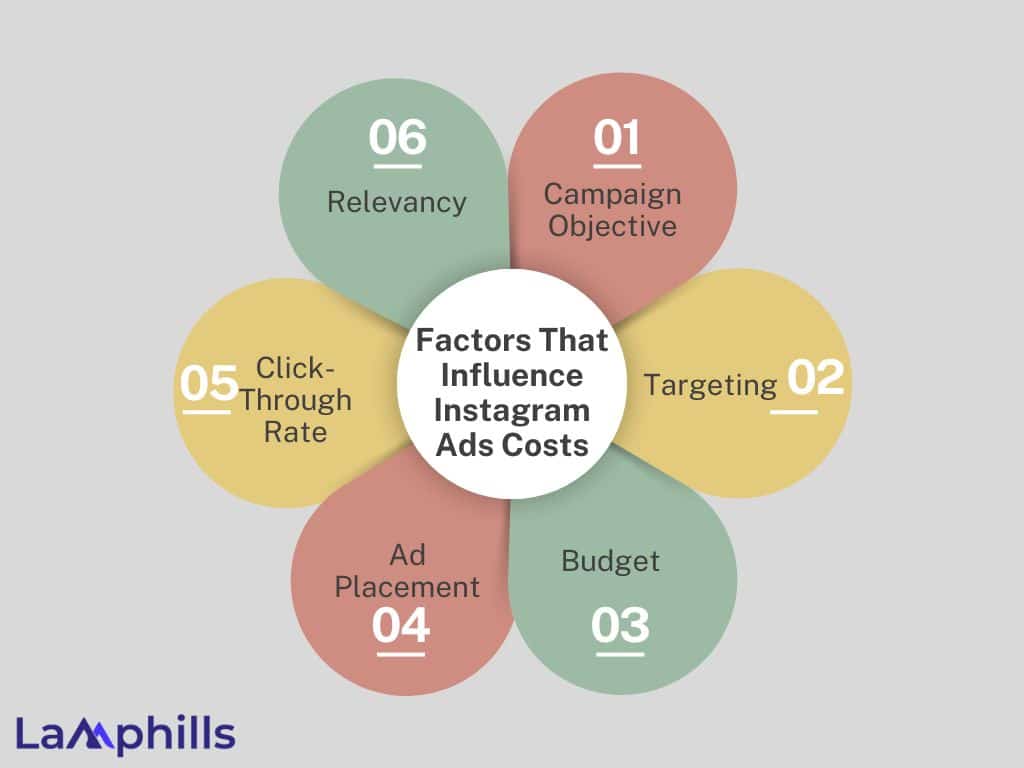
Instagram ad costs are determined by many different factors. Based on these factors, the ads manager decides how much it would cost to run your ad. Look at how to improve these to reduce your monthly Instagram ad cost.
#1. Campaign Objective
Your ad expenses can automatically increase or decrease based on your choice of campaign objectives and how they relate to the stage of the funnel at which your target audience is.
For example, if you select a brand awareness campaign objective, it will be lower in cost than something lower down the funnel with a higher-value objective, such as conversions. Having broader, colder audiences see your ad to drive brand awareness is a lower-value action compared to targeting a user further down the funnel—who are more familiar with your brand and offerings and ready to open their wallet or take a higher-value action.
#2. Targeting
Instagram ad costs are often higher for specific demographics and industries than the others. This usually indicates many advertisers are competing for that spot.
For example, ads for women’s fashion will naturally cost you more due to the competition in the industry. However, ads for niche industries won’t cost you much.
The demographics you target also affect your Instagram ad costs. For example, targeting millennials and Generation Z would cost you more due to the platform’s popularity among these generations.
Also, showing your ads to a B2B audience is more costly than B2C. The answer is simple: There are fewer businesses on Instagram than people, and the value advertisers get from them is even higher.
#3. Budget
The budget also influences Instagram ad costs because if you have a small budget, it may take longer to get out of the Learning Phase if your campaign or ad set is starting anew. Costs may be more expensive before the system learns and understands your campaign type and optimization goals and how your audience engages with your ads. If your ads are well engaged, Facebook and Instagram will reward you with lower costs over time.
#4. Ad Placement
Instagram ads are shown in many different places. When you are setting up Instagram ads, you’re asked where you want to place your ad. The ad placement is one of the factors that determine the cost of Instagram ads.
The places where you can showcase your ads on Instagram are as follows:
- Stories
- Feed posts
- The explore page
- IGTV
The most engaging placements cost advertisers more to put their ads there. For example, Instagram story ads are cheaper than Feed ads as they are on user screens just for a few seconds. This is also why most advertisers prefer Feed ads over Story ads.
#5. Click-Through Rate
Lower CTR indicates that the system may see a discrepancy between the messaging in your ads and the people you are trying to reach. As a result, you could see greater prices. The click-through rate (CTR) is a powerful indicator of how well your ads are connecting with your target demographic. The CTR should be no more than 2%. You ought to observe a drop in expenses if your CTR is healthy.
#6. Relevancy
Relevancy plays a crucial role in determining Instagram ad costs. Instagram wants to make sure that the people who are seeing your ads are interested in them.
Instagram aims to provide the best user experience, even when it comes to ads. Thus, ad relevancy is an essential factor.
Positive responses to your ads, such as likes, shares, and comments, serve as a gauge of their relevancy. A lower relevancy score is the result of negative responses like concealing or reporting your ad.
Instagram ads with a 6+ relevancy score would appear more frequently than those with a lower score. This way you can reduce your Instagram advertising costs and get more clicks and conversions.
What Is the Minimum Budget for Instagram Ads?
According to the Meta Business Help Center, Instagram recommends starting with a minimum budget of at least $5 for your ad and running it for more than six days. This allows the ad delivery system to find the best people for your ad. However, the amount you need to spend depends on the results you want to achieve.
Is It Worth It to Pay for Instagram Ads?
Compared to other marketing strategies, Instagram ads are orders of magnitude less expensive. Therefore, it is worth using this platform, at a minimum, to test whether your audience responds to such activities. At the same time, the budget that will be needed is only 1 dollar per day. Where else can you test marketing hypotheses at such a low cost? Is Instagram advertising right for your business?
If the platform is popular with your target audience or your business targets the 25-34 age group (according to Statista, 33% of all Instagram users are in this group), social media can be a powerful communication tool with your potential buyers. You can serve ads to over 1 billion active users on the platform (according to business.instagram.com).
How Much Does Instagram Advertising Cost Per Month?
Instagram ads cost per month varies based on different factors like target audience, bidding strategy, location, etc. I have given below the average monthly ad cost for different ad types.
- Stories ads: $18-$54 per month
- Image ads: $12-$48 per month
- Video ads: $30-$120 per month
- Carousel ads: $24-$60 per month
(Please note: These are just the costs for different ad formats; the actual costs may be higher or lower than that.)
How to Optimize Ad Spend on Instagram?
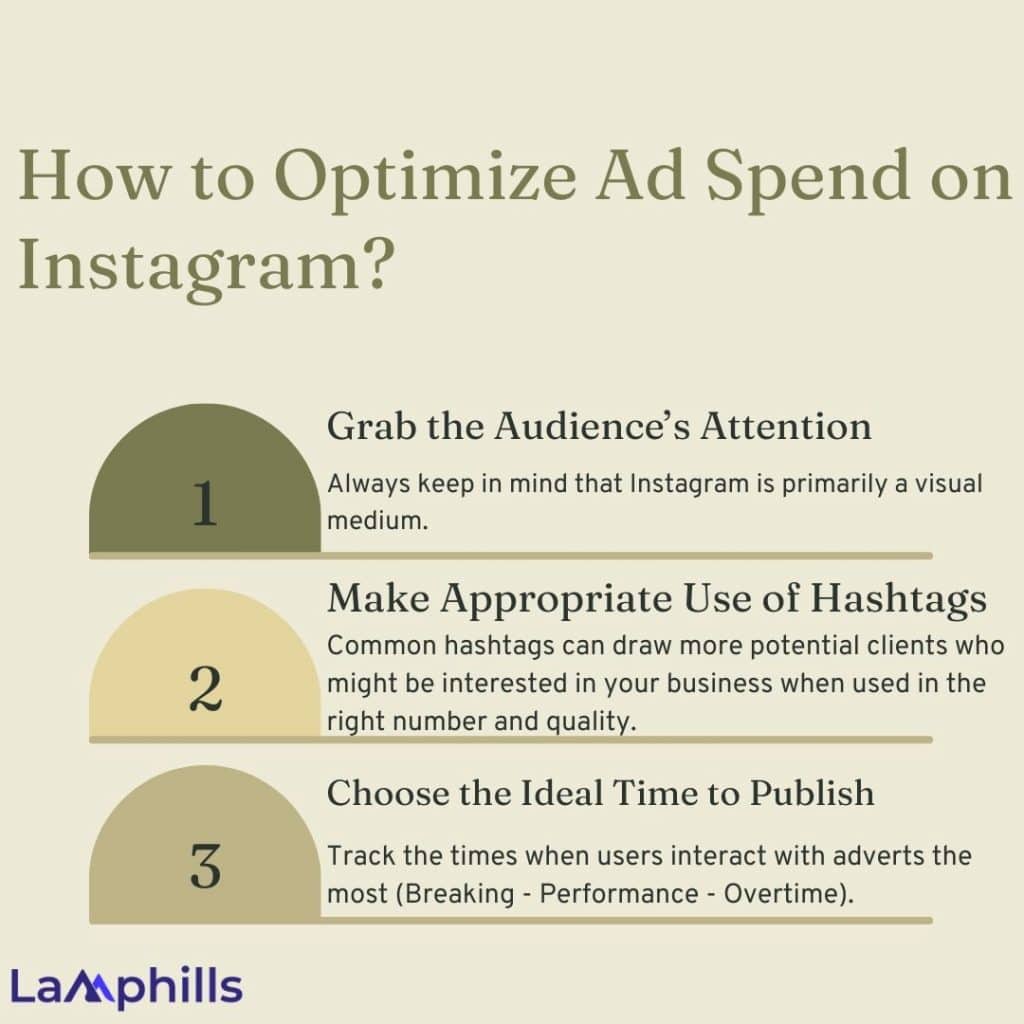
When it became clear, “How much do Instagram ads cost?” it’s time to understand how to optimize costs so that the result remains as effective as possible.
Don’t be afraid of high stakes on Instagram. They are often accessible to optimize:
#1. Grab the Audience’s Attention
Always keep in mind that Instagram is primarily a visual medium. In the opening two seconds of the video, grab the audience’s attention using eye-catching and imaginative films, GIF banners, and visual effects. Since most people don’t view videos with sound, add text to the video, experiment with different CTAs, and try other formats. Analyze every piece of information to make the upcoming ad campaign even more effective than the last.
#2. Make Appropriate Use of Hashtags
Common hashtags can draw more potential clients who might be interested in your business when used in the right number and quality. Make sure you use and investigate every hashtag related to your industry.
#3. Choose the Ideal Time to Publish
Track the times when users interact with adverts the most (Breaking – Performance – Overtime). Attempt to post at this time. With this method, you’ll spend less on Instagram ads and still get the best results.
Instagram ad optimization is a process that requires a lot of trial and error. This is a reason to work with experts in Instagram ad campaign setup if you need results quickly.
Check out our Instagram ad campaign planning template below. This template should help you organize and execute a well-planned Instagram ad campaign, ensuring all critical aspects are covered. Adjust the sections as needed based on your specific campaign requirements.
Lamphills Instagram Ad Campaign Planning Template
How Can You Lower Your Instagram Ads Cost?
Regarding social media ads, you want to do whatever you can to reduce ad costs. Below are a couple of best practices that can help you reduce the expense of your Instagram ads and maximize your return:
#1. Use Automatic Bidding
For your campaign, automatic bidding is a good option if you have never utilized Instagram ads before. It is an easy method for you to obtain a bid that is suitable for your campaign.
Automatic bidding is the best option if you don’t have any historical data to inform you of a good CPC (Cost per Click) to set for your campaign. This will help you determine the bid amount that matches your campaign.
By utilizing automatic bidding, your business can prevent overpaying to advertise. A lack of previous data can make it challenging to know the right bid amount, so you might bid more than you need to.
In addition, automatic bidding is an intelligent way to minimize the expense of your Instagram ads.
#2. Set Goals
Setting goals will help maintain focus on what you want to accomplish with your ad.
There are three main goals you should focus on attaining with your Instagram Ads:
- Awareness: You should concentrate on growing awareness about your company, brand, product, app, or service through an awareness campaign. You want to call attention to it and help people be familiar with it. To achieve this goal, you will focus on running a CPM campaign.
- Consideration: If your goal is a consideration, you will focus more on educating your audience. You’ll want to give more persuasive information to your audience, which will get them to convert. To this end, you will focus on earning clicks, views, and leads.
- Conversion: Many businesses aim to get customers to buy goods, install apps, or use services. If you focus on conversions for your campaign goal, you want a persuasive copy that will get your audience to buy your products or use your services immediately.
Setting goals will create a much more cohesive campaign. Compelling ad copy leads to more significant interactions and conversions.
#3. Create Content-Related Landing Pages
The majority of companies mistakenly send leads to their main website when they click on their Instagram ad. As a result of users not being directed to an ad-relevant landing page, this discourages engagement. It all boils down to utilizing a solid coherence-building web design method.
Customers are more likely to convert if they are directed straight to the product. Alternatively, even better, to an interactive product catalog that features every item you sell. Your advertising strategies will be far more optimized as a result.
Check out the video below to learn more about lowering your Instagram ad cost.
Bottom Line
Instagram continues to grow, and advertising options have only become more robust. It’s not yet saturated, and it’s safe to assume that more ad placements will come our way.
Give Instagram Ads a test and see how they compare to other advertising platforms you may be running. They can become an essential part of your funnel by driving more brand awareness and engagement or a primary source of revenue.
Similar Articles
- Google Ads for Beginners: Step-by-Step Guide to Success
- How Much Does Organic Content Cost? A Comprehensive Guide
- Paid vs. Organic Search: Which Strategy is Right for You?





